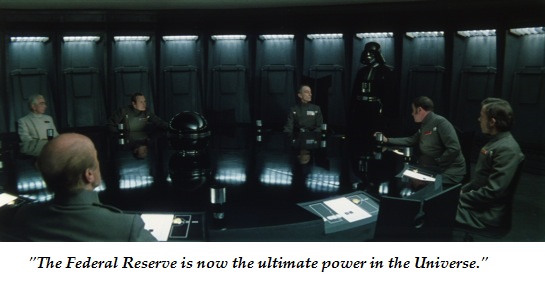There are several problems with the notion that risk can always be neutralized with counterparty securities and/or central bank liquidity. The first is fundamental. As mathematician Benoit Mandelbrot showed in his seminal book The (Mis)behavior of Markets, risk is a feature of all markets. As a result of their fractal nature, risk cannot be eliminated, and claims that risk has been eliminated will fail catastrophically.
In other words, precisely what happened in 2008-2009, when all the "low-risk" trades blew up and nearly took the global financial system down.
The second reason has to do with the failure of conventional models to assess tail risk. As former Federal Reserve chairman Alan Greenspan confessed in Foreign Affairs, Why I Didn't See the Crisis Coming, the Fed's models failed to accurately account for tail risk (otherwise known as things that supposedly happen only rarely but when they do happen, they're a doozy), because guess what–they happen far more often than statistical models predict.
If Greenspan had read Mandelbrot's book, he would have known that.
The third reason is human nature. As Greenspan observed, conventional models assume markets will remain liquid during crises. But in the real world, when panic takes hold, sellers/bids completely disappear and markets freeze up. Assets that cannot be sold are rendered worthless.
Risk, which has supposedly been disappeared by hedging, erupts and what is supposed to be permanent–liquidity–disappears.
This leads to the fourth problem, which is counterparty hedging is only as good as the liquidity of the market and the solvency of the counterparty.
It's all well and good to hedge a position with a counterparty-issued security, but if the counterparty can't pay off the hedge when things go south, the hedge disappears and the loss must be swallowed whole.
That leads to the fifth problem, which is in highly leveraged bets, a modest loss leads to insolvency. To quote Marx, "All that is solid melts into air."
The sixth problem is systemic. Risk, by its very nature, flows to where it is least expected–into the parts of the system that are perceived as "safe."
Thus risk in 2002 to 2007 flowed into home mortgages, the part of the financial system that was widely viewed as low-risk.
So where is all the systemic risk now? Like generals preparing to fight the last war, the Fed and other central banks are focused on protecting the mortgage market, Too Big to Fail/Jail (TBTF/J) banks and sovereign bonds, as those were the sectors where risk erupted last time.
(Note that the Fed has bought about $2 trillion of U.S. mortgages since 2009, about 20% of the entire market. That's one way to soak up risk: just put a bid under the market and buy, buy, buy, burying it all in central bank balance sheets and government pension funds.)
But risk can't be disappeared; it can only be transferred or temporarily cloaked. So where has all the risk pooled up in the system? In foreign exchange (FX) markets, that's where. The $11 trillion in carry trades the central banks have funded are being deleveraged in a rapidly destabilizing environment of Japan devaluing its currency, the yen, by 40% since late 2012, and the withdrawal of the Fed's $1 trillion-a-year QE programs.
I'll give you two examples of risk piling up in the FX market. The consensus is that the Fed ending $1 trillion/year in QE money issuance is no big deal because the Bank of Japan (BoJ) and the European Central Bank (ECB) are printing more money, which is taking the place of the Fed's QE issuance.
Not so fast, Slick. Roughly two-thirds of the emerging-market debt that must be liquidated or rolled over is denominated in dollars, which means the borrowers still need dollars, not yen or euros or yuan. So the strengthening dollar will still bite all these emerging-market borrowers with very sharp teeth.
Printing yen and euros is not a direct substitute for the dollars that have ceased flowing.
Then there's all the high-fiving when trade deals are announced between China and whomever. Nice, but everyone crowing about a de-dollarized trade has forgotten that China's RMB (yuan) is pegged to the U.S. dollar. That means that the rising dollar is dragging the RMB higher in relation to rubles, yen, euros, pesos, quatloos, etc.
The risks unleashed by central bank funding of massive carry trades, policy-driven devaluations and currency crises have yet to manifest. When they do, we'll rediscover why traders consider the FX market the 800-pound gorilla that stomps on the stock and bond markets without even noticing the squishing sound.




